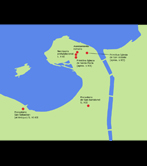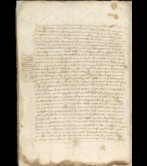The founding of San Sebastián
Archaeological excavations in the Santa Teresa convent reveal Roman traces and, having been hidden for centuries, a necropolis beside the church which dates from at least the 10th century. This fits in with the spread of monks who lived off the land. The livestock routes across the lower valleys of Urumea, Oria and Urola are marked on a document in 1025, which contains the first mention of “Ipuscoa”. The San Sebastián monastery (now the site of the Miramar Palace) has played an important role in the history of Gipuzkoa since the 11th century.
San Sebastián was founded as a villa by the Navarrese king Sancho VI the Wise at the end of the 12th century, probably in 1180, as part of the crown of Navarra’s wider strategy. Clearly there were people there before it was granted the judicial and political status of a fuero (bill of rights). There are written records of the churches San Vicente and Santa María in 1178. These churches perhaps reflect the distinctive origin of Donostia’s original primitive inhabitants: both locals and Gascon (from south-west France). It is well known that there were communities of Gascon origin around Baiona and the mouth of the Bidasoa and the Urumea and the Bay of Pasaia. During the late Middle Ages they controlled numerous seats of power, among them the Donostia council and have left traces in the calendar and in place names (Embeltran, Narrica, Morlaans, Aiete, Monpas). There are also documents written in their language.
In founding the villa, the Navarra monarchy sought to consolidate the existing population and encourage the settlement of traders and seafarers. The need for the existing residents to approve the inclusion of the Navarrese in the new villa was based less on their ethnicity or their place of origin than their activity, to differentiate between the farmers (Navarrese) and the villa residents (French). Among other advantages, they were exempt from the military draft and also from purchase and trading taxes. The inhabitants were given the right to be tried in their own villa, under their own laws and based on the Fuero de Estella, from which Donostia derived its status.
A wide area came under the jurisdiction of Donostia, from the mouth of the Bidasoa to that of the Oria, and from the coast as far as Arano, in Navarra. The fact that other villas (Hondarribia, Errenteria, Hernani, Orio) fell within its territory gave rise to a number of lawsuits, in particular over the control of the Bay of Pasaia. Although the villa’s natural point of anchorage was in the Concha below Urgull, next to the city walls, the Santa Catalina wharf and shipyard were on the other side of the isthmus, at the mouth of the Urumea, and because they could accommodate bigger ships, the San Pedro and Herrera side became the principal port of Donostia. Donostia exported iron from Gipuzkoa and wool from Navarra and imported fabric from Flanders. Even after Gipuzkoa have been incorporated into Castile, the crown of Navarra still preferred to trade through San Sebastián. The villa, along with others in Gipuzkoa, established its own mechanisms to promote trade, such as a trade agreement with Baiona and England, the “Hermandad de las Marismas” (the Marshes Association) made up of several coastal villas with links to Victoria etc.
In common with Hondarribia, also a fortified town, Donostia had a castle and later extended its walls to create what was almost a citadel, which was knocked down in 1864 in order to build the first urban extension. Remains of the fortifications can be seen in the underground car park on the Boulevard. The Mota castle, situated above Urgull, was built on top of another fortified building which was first recorded in 1199 when the villa had already been founded. The fort that you see today dates from the 15th century, and was probably rebuilt around 1525. The remains of the walls, batteries etc. that lie against mount Urgull are from later centuries.




